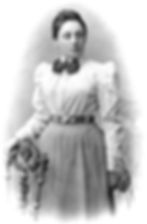Traversing symmetries, invariants, ideals, and rings.

To a lot of people, math has a bit of a bad reputation for being too abstract. Instead of dealing with specific examples, math often uses a broader, general representation of a problem that captures the essentials of what’s going on. One example is algebra. By using abstract variables to stand in for specific numbers, you can write and prove formulas that apply to a wide variety of cases. The variables are left only with the properties common to all numbers, and so tell us what relations are true in general versus what is true only for certain numbers.
Abstraction can be difficult to wrap your head around, but it is a powerful tool for seeing the bigger picture of a problem. It’s like looking up from studying a specific tree, and realizing that you’re surrounded by an entire forest.


Throughout the twentieth century, math was getting more abstract than ever before, and one of the people at the forefront of this wave was a mathematician named Emmy Noether. Noether was a pretty unique figure in her time. For one, she was very comfortable with thinking about the abstract; to her, the true meaning of math could only be seen once it was separated from particular and expanded to the general. For another, Emmy was a woman in a field that had long been dominated by men.
Albert Einstein once said that Dr. Noether was one of the most important women in the history of math.
Watch the video or continue reading the blog below!
Emmy's Education
Emmy Noether was born in Germany in 1882. In her time it was unusual for women to attend university; when she enrolled at the University of Erlangen there was only one other female student! In fact, her university didn’t technically have female students. Women like Noether were only allowed to audit courses, and only after getting permission from each of the professors. But she kept working, and soon changes in German society led to women being able to attend college the same way men could. Soon enough, Noether was able to defend her dissertation and receive her doctorate.
But the newly minted Dr. Noether then encountered another obstacle. In Germany, the next step for an academic was to pursue habilitation, an exam that was required to get a job as a university professor, and while Noether was more than ready to take it, women were barred from the test. Still, Noether would not let anything keep her from math. She was kept from a professional position, so she simply did her research unpaid, assisting her father with his work. And as her “amateur” research became published, her reputation grew.

"Roughly a century later, Noether’s theorem is still recognized as one of the most important in all of physics."
Noether's Theorem

In 1915 Noether was invited to the University of Göttingen, one of the centers of math in Europe, by prominent mathematicians David Hilbert and Felix Klein, who were eager to hear her thoughts on a problem of theirs. This eagerness was not shared by many of the faculty. When the invitation was being decided on, another professor complained that the students couldn’t be expected to learn “at the feet of a woman.” Hilbert told him that the gender of a teacher is totally irrelevant—as he said it, “we are a university, not a bathhouse.” Noether’s invitation was approved by the university, and she shipped off to Göttingen.
The main reason that Hilbert and Klein invited Dr. Noether was to consult with her on one of the most important concepts in physics—the idea of conservation. A quantity is conserved if it does not change over time. Things like momentum and energy are conserved, a fact that is very useful in solving physics problems. But why are certain quantities conserved and others aren’t? Hilbert and Klein were trying to find the answer. They sought out Noether because she was an expert in the study of invariants, mathematical quantities that remain unchanged under transformations.

After a few years of work, Dr. Noether was able to find an answer to their question. Her answer, called Noether’s theorem, found that these conservation laws arise from the symmetries of a system. For example, the fact that momentum is conserved comes from something called translational invariance, which means the laws of physics are the same at any position. The conservation of energy, on the other hand, comes from time invariance, or the fact that the laws of physics are the same throughout time.
In addition to telling us why things are conserved, Noether’s theorem also tells us how to find new conserved quantities—we only need to look for the symmetries of the system, and the rest will follow. This viewpoint was incredibly important for a new type of physics that was emerging at the time called quantum mechanics. Roughly a century later, Noether’s theorem is still recognized as one of the most important in all of physics.
Rings and Ideals
Despite this essential contribution, physics was not actually Noether’s specialty. Instead, most of her work was devoted to the study of abstract algebra. Abstract algebra is the study of structures, which are essentially the operations we can put on a collection of objects that follow specific rules. For example, when you multiply numbers, it doesn’t matter how we group them: 2 x (3 x 4) is the same as (2 x 3) x 4. This is called associativity.

This, along with seven other properties, show that numbers have a special type of structure called a ring. But these same rules of addition and multiplication also apply not just to single numbers, but also to numbers in a certain square grid, called a 2 x 2 matrix. Because matrix multiplication follows the same rules, the set of 2 x 2 matrices can also be called a ring.

By noticing that the structures of these two objects are the same, we’re able to deduce properties shared by both!
This trend of abstraction started late in the 1800s then really started running in the 1900s, and Emmy Noether was one of the best at it. Noether abstracted often, most famously creating the abstract definition of ideals, an important concept in the study of rings. While at Göttingen she laid the foundations for the study of “commutative rings”, generalizing earlier work on polynomials and numbers and combining many separate results on these concrete objects into but a few general results. Doing so not only expanded these theorems’ scope, it also revealed what properties of polynomials or numbers made the old theorems true.
The Power of Abstraction
To Emmy Noether, this was the power of abstraction. By stripping away all of the unnecessary details of the concrete cases, she could find the fundamental ideas that made the results hold. Throughout her career, she grappled with abstract mathematical truths, teasing them out and masterfully manipulating them. This type of “purely conceptual” thinking remains incredibly important not only in algebra, but in many other fields across math and science.
"Instead of spending her time focused on specific trees of mathematics, Emmy Noether was determined to hike to the top of the mountain to ... show all of us the incredible view."
It would still take a few years until women were allowed to become habilitated in Germany. But it did eventually change, and Noether received her certification in short order. And after another few years, she would be given a true professorship. One of the most prominent mathematicians in the world was finally able to get paid for her work.

But the course of Noether’s career never did run smooth. In 1933, the year Adolf Hitler became the Chancellor of Germany, an increase of anti-Semitism led to Jewish government employees being ousted from their positions. This included Noether and many of her colleagues. She would continue to work on math and hold informal lectures in her apartment, but would soon join the wave of German professors emigrating to the United States. She worked the rest of her life at Bryn Mawr College in Pennsylvania.

Noether left behind a mathematical legacy like few others. Her famous theorem has become a critical part of modern physics, and her work in abstract algebra has shaped the way we study the field to this day. Instead of spending her time focused on the specific trees of mathematics, Emmy Noether was determined to hike to the top of the mountain to appreciate the view of the entire forest. And even though she was held back at every step of her journey, she made it to the top and showed us all the incredible view.
Photos courtesy of Wikimedia Commons and Getty Images
Written by Justin Toyota
Edited by Caroline Martin
Illustrations by Sachi Weerasooriya
Portrait by IG: s_c_r_u_b_y
Primary sources and additional readings:
Intro to Matrices by Khan Academy
Ring (mathematics) from Kiddle
A Century of Noether’s Theorem by Chris Quigg
“Emmy Noether” from University of St. Andrews
Explore a world of math and abstraction!
Expand (30-45 minutes): Emmy Noether did brilliant work in the field of abstract algebra, which includes the study of things like fields, lattices, and vectors. To learn about how to think about vectors, check out this activity!
Deepen (30-45 minutes): If you’re interested in learning more about linear algebra, vectors, and matrices, keep reading to learn more! We recommend working through Chapters 1-4.
Interact (10-20 minutes): Noether’s work on conservation laws is some of the most important in all of physics. Momentum is an example of a conserved quantity! Try experimenting with this simulation to see how momentum works and what happens when two objects collide!